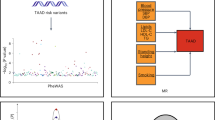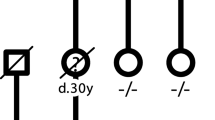Abstract
Thoracic aortic aneurysm (TAA) is a genetic disease predisposing to aortic dissection. It is important to identify the genetic modifiers controlling penetrance and expressivity to improve clinical prognostication. Exome sequencing was performed in 27 subjects with syndromic or familial TAA presenting with extreme phenotypes (15 with severe TAA; 12 with mild or absent TAA). Family-based analysis of a subset of the cohort identified variants, genes, and pathways segregating with TAA severity among three families. A rare missense variant in ADCK4 (p.Arg63Trp) segregated with mild TAA in each family. Genes and pathways identified in families were further investigated in the entire cohort using the optimal unified sequence kernel association test, finding significance for the gene COL15A1 (p = 0.025) and the retina homeostasis pathway (p = 0.035). Thus, we identified candidate genetic modifiers of TAA severity by exome-based study of extreme phenotypes, which may lead to improved risk stratification and development of new medical therapies.





Similar content being viewed by others
Abbreviations
- ARS:
-
Aortic replacement surgery
- CTD:
-
Connective tissue disorder
- ECM:
-
Extracellular matrix
- GO BP:
-
Gene Ontology biological process
- MFS:
-
Marfan syndrome
- MRI:
-
Magnetic resonance imaging
- SKAT-O:
-
Optimal unified sequence kernel association test
- TAA:
-
Thoracic aortic aneurysm
- TGFβ:
-
Transforming growth factor beta
- WES:
-
Whole exome sequencing
References
Kochanek, K. D., Murphy, S. L., & Xu, J. (2015). Deaths: final data for 2011. National Vital Statistics Reports, 63(3), 1–120.
Hiratzka, L. F., Bakris, G. L., Beckman, J. A., Bersin, R. M., Carr, V. F., Casey Jr., D. E., et al. (2010). 2010 ACCF/AHA/AATS/ACR/ASA/SCA/SCAI/SIR/STS/SVM guidelines for the diagnosis and management of patients with thoracic aortic disease: a report of the American College of Cardiology Foundation/American Heart Association Task Force on Practice Guidelines, American Association for Thoracic Surgery, American College of Radiology, American Stroke Association, Society of Cardiovascular Anesthesiologists, Society for Cardiovascular Angiography and Interventions, Society of Interventional Radiology, Society of Thoracic Surgeons, and Society for Vascular Medicine. Circulation, 121(13), e266–e369. doi:10.1161/CIR.0b013e3181d4739e.
Pape, L. A., Tsai, T. T., Isselbacher, E. M., Oh, J. K., O’Gara, P. T., Evangelista, A., et al. (2007). Aortic diameter >or = 5.5 cm is not a good predictor of type A aortic dissection: observations from the International Registry of Acute Aortic Dissection (IRAD). Circulation, 116(10), 1120–1127. doi:10.1161/circulationaha.107.702720.
Dietz, H. C., Cutting, G. R., Pyeritz, R. E., Maslen, C. L., Sakai, L. Y., Corson, G. M., et al. (1991). Marfan syndrome caused by a recurrent de novo missense mutation in the fibrillin gene. Nature, 352(6333), 337–339. doi:10.1038/352337a0.
Loeys, B. L., Schwarze, U., Holm, T., Callewaert, B. L., Thomas, G. H., Pannu, H., et al. (2006). Aneurysm syndromes caused by mutations in the TGF-beta receptor. The New England Journal of Medicine, 355(8), 788–798. doi:10.1056/NEJMoa055695.
Superti-Furga, A., Steinmann, B., Ramirez, F., & Byers, P. H. (1989). Molecular defects of type III procollagen in Ehlers-Danlos syndrome type IV. Human Genetics, 82(2), 104–108.
Milewicz, D. M., Trybus, K. M., Guo, D. C., Sweeney, H. L., Regalado, E., Kamm, K., et al. (2017). Altered smooth muscle cell force generation as a driver of thoracic aortic aneurysms and dissections. Arteriosclerosis, Thrombosis, and Vascular Biology, 37(1), 26–34. doi:10.1161/atvbaha.116.303229.
Faivre, L., Collod-Beroud, G., Loeys, B. L., Child, A., Binquet, C., Gautier, E., et al. (2007). Effect of mutation type and location on clinical outcome in 1,013 probands with Marfan syndrome or related phenotypes and FBN1 mutations: an international study. American Journal of Human Genetics, 81(3), 454–466. doi:10.1086/520125.
Milewicz, D. M., & Regalado, E. S. (2015). Use of genetics for personalized management of heritable thoracic aortic disease: how do we get there? The Journal of Thoracic and Cardiovascular Surgery, 149(2 Suppl), S3–S5. doi:10.1016/j.jtcvs.2014.07.070.
Landis, B. J., Ware, S. M., James, J., Shikany, A. R., Martin, L. J., & Hinton, R. B. (2015). Clinical stratification of pediatric patients with idiopathic thoracic aortic aneurysm. The Journal of Pediatrics, 167(1), 131–137.e131-135. doi:10.1016/j.jpeds.2015.02.042.
Colan, S. D., McElhinney, D. B., Crawford, E. C., Keane, J. F., & Lock, J. E. (2006). Validation and re-evaluation of a discriminant model predicting anatomic suitability for biventricular repair in neonates with aortic stenosis. Journal of the American College of Cardiology, 47(9), 1858–1865. doi:10.1016/j.jacc.2006.02.020.
Lopez, L., Colan, S. D., Frommelt, P. C., Ensing, G. J., Kendall, K., Younoszai, A. K., et al. (2010). Recommendations for quantification methods during the performance of a pediatric echocardiogram: a report from the Pediatric Measurements Writing Group of the American Society of Echocardiography Pediatric and Congenital Heart Disease Council. Journal of the American Society of Echocardiography, 23(5), 465–495; quiz 576-467. doi:10.1016/j.echo.2010.03.019.
Chen, J., Bardes, E. E., Aronow, B. J., & Jegga, A. G. (2009). ToppGene Suite for gene list enrichment analysis and candidate gene prioritization. Nucleic Acids Research, 37(Web Server issue), W305–W311. doi:10.1093/nar/gkp427.
Lee, S., Emond, M. J., Bamshad, M. J., Barnes, K. C., Rieder, M. J., Nickerson, D. A., et al. (2012). Optimal unified approach for rare-variant association testing with application to small-sample case-control whole-exome sequencing studies. American Journal of Human Genetics, 91(2), 224–237. doi:10.1016/j.ajhg.2012.06.007.
Farlow, J. L., Robak, L. A., Hetrick, K., Bowling, K., Boerwinkle, E., Coban-Akdemir, Z. H., et al. (2016). Whole-exome sequencing in familial Parkinson disease. JAMA Neurology, 73(1), 68–75. doi:10.1001/jamaneurol.2015.3266.
Loeys, B. L., Dietz, H. C., Braverman, A. C., Callewaert, B. L., De Backer, J., Devereux, R. B., et al. (2010). The revised Ghent nosology for the Marfan syndrome. Journal of Medical Genetics, 47(7), 476–485. doi:10.1136/jmg.2009.072785.
Richards, S., Aziz, N., Bale, S., Bick, D., Das, S., Gastier-Foster, J., et al. (2015). Standards and guidelines for the interpretation of sequence variants: a joint consensus recommendation of the American College of Medical Genetics and Genomics and the Association for Molecular Pathology. Genetics in Medicine, 17(5), 405–424. doi:10.1038/gim.2015.30.
Schubert, J. A., Landis, B. J., Shikany, A. R., Hinton, R. B., & Ware, S. M. (2016). Clinically relevant variants identified in thoracic aortic aneurysm patients by research exome sequencing. American Journal of Medical Genetics. Part A, 170(5), 1288–1294. doi:10.1002/ajmg.a.37568.
Halme, T., Savunen, T., Aho, H., Vihersaari, T., & Penttinen, R. (1985). Elastin and collagen in the aortic wall: changes in the Marfan syndrome and annuloaortic ectasia. Experimental and Molecular Pathology, 43(1), 1–12.
Wang, X., LeMaire, S. A., Chen, L., Shen, Y. H., Gan, Y., Bartsch, H., et al. (2006). Increased collagen deposition and elevated expression of connective tissue growth factor in human thoracic aortic dissection. Circulation, 114(1 Suppl), I200–I205. doi:10.1161/circulationaha.105.000240.
Maleszewski, J. J., Miller, D. V., Lu, J., Dietz, H. C., & Halushka, M. K. (2009). Histopathologic findings in ascending aortas from individuals with Loeys-Dietz syndrome (LDS). The American Journal of Surgical Pathology, 33(2), 194–201. doi:10.1097/PAS.0b013e31817f3661.
Marneros, A. G., & Olsen, B. R. (2001). The role of collagen-derived proteolytic fragments in angiogenesis. Matrix Biology, 20(5–6), 337–345.
Ware, S. M., Shikany, A., Landis, B. J., James, J. F., & Hinton, R. B. (2014). Twins with progressive thoracic aortic aneurysm, recurrent dissection and ACTA2 mutation. Pediatrics, 134(4), e1218–e1223. doi:10.1542/peds.2013-2503.
Korkmaz, E., Lipska-Zietkiewicz, B. S., Boyer, O., Gribouval, O., Fourrage, C., Tabatabaei, M., et al. (2016). ADCK4-associated glomerulopathy causes adolescence-onset FSGS. Journal of the American Society of Nephrology, 27(1), 63–68. doi:10.1681/asn.2014121240.
Duvvari, M. R., van de Ven, J. P., Geerlings, M. J., Saksens, N. T., Bakker, B., Henkes, A., et al. (2016). Whole exome sequencing in patients with the cuticular drusen subtype of age-related macular degeneration. PloS One, 11(3), e0152047. doi:10.1371/journal.pone.0152047.
Brunetti-Pierri, N., Pignatelli, R., Fouladi, N., Towbin, J. A., Belmont, J. W., Craigen, W. J., et al. (2011). Dilation of the aortic root in mitochondrial disease patients. Molecular Genetics and Metabolism, 103(2), 167–170. doi:10.1016/j.ymgme.2011.02.007.
Emrich, F. C., Okamura, H., Dalal, A. R., Penov, K., Merk, D. R., Raaz, U., et al. (2015). Enhanced caspase activity contributes to aortic wall remodeling and early aneurysm development in a murine model of Marfan syndrome. Arteriosclerosis, Thrombosis, and Vascular Biology, 35(1), 146–154. doi:10.1161/atvbaha.114.304364.
Kuang, S. Q., Medina-Martinez, O., Guo, D. C., Gong, L., Regalado, E. S., Reynolds, C. L., et al. (2016). FOXE3 mutations predispose to thoracic aortic aneurysms and dissections. The Journal of Clinical Investigation, 126(3), 948–961. doi:10.1172/jci83778.
Yang, H. H., van Breemen, C., & Chung, A. W. (2010). Vasomotor dysfunction in the thoracic aorta of Marfan syndrome is associated with accumulation of oxidative stress. Vascular Pharmacology, 52(1–2), 37–45. doi:10.1016/j.vph.2009.10.005.
Branchetti, E., Poggio, P., Sainger, R., Shang, E., Grau, J. B., Jackson, B. M., et al. (2013). Oxidative stress modulates vascular smooth muscle cell phenotype via CTGF in thoracic aortic aneurysm. Cardiovascular Research, 100(2), 316–324. doi:10.1093/cvr/cvt205.
Lee, Y. C., Huang, H. Y., Chang, C. J., Cheng, C. H., & Chen, Y. T. (2010). Mitochondrial GLUT10 facilitates dehydroascorbic acid import and protects cells against oxidative stress: mechanistic insight into arterial tortuosity syndrome. Human Molecular Genetics, 19(19), 3721–3733. doi:10.1093/hmg/ddq286.
Ashraf, S., Gee, H. Y., Woerner, S., Xie, L. X., Vega-Warner, V., Lovric, S., et al. (2013). ADCK4 mutations promote steroid-resistant nephrotic syndrome through CoQ10 biosynthesis disruption. The Journal of Clinical Investigation, 123(12), 5179–5189. doi:10.1172/jci69000.
Harper, A. R., Nayee, S., & Topol, E. J. (2015). Protective alleles and modifier variants in human health and disease. Nature Reviews. Genetics, 16(12), 689–701. doi:10.1038/nrg4017.
Zilberberg, L., Phoon, C. K., Robertson, I., Dabovic, B., Ramirez, F., & Rifkin, D. B. (2015). Genetic analysis of the contribution of LTBP-3 to thoracic aneurysm in Marfan syndrome. Proceedings of the National Academy of Sciences of the United States of America, 112(45), 14012–14017. doi:10.1073/pnas.1507652112.
Miles, L. A., Garippa, R. J., & Poirier, J. T. (2016). Design, execution, and analysis of pooled in vitro CRISPR/Cas9 screens. The FEBS Journal, 283(17), 3170–3180. doi:10.1111/febs.13770.
Acknowledgments
We thank the Heart Institute Research Core (recruitment), the Genetic Variation and Gene Discovery Core (sequencing), Phil Dexheimer, Osniel Ramos-Gonzales, and Amy Opoka for their assistance.
Author information
Authors and Affiliations
Corresponding authors
Ethics declarations
Sources of Funding
This study was supported by a National Institutes of Health (Bethesda, MD) K12HD068371 (BJL), a Burroughs Wellcome Fund (Research Triangle Park, NC) Clinical Scientist Award in Translational Research #1008496 (SMW), and an American Heart Association (Dallas, TX) Innovative Research Grant 14IRG18830027 (RBH).
Conflict of Interest
The authors declare that they have no conflict of interest.
Human Subjects/Informed Consent Statement
All procedures performed in studies involving human participants were in accordance with the ethical standards of the institutional and/or national research committee and with the 1964 Helsinki Declaration and its later amendments or comparable ethical standards. Informed consent was obtained from all individual participants included in the study.
Electronic supplementary material
ESM 1
(DOCX 38 kb)
Rights and permissions
About this article
Cite this article
Landis, B.J., Schubert, J.A., Lai, D. et al. Exome Sequencing Identifies Candidate Genetic Modifiers of Syndromic and Familial Thoracic Aortic Aneurysm Severity. J. of Cardiovasc. Trans. Res. 10, 423–432 (2017). https://doi.org/10.1007/s12265-017-9753-1
Received:
Accepted:
Published:
Issue Date:
DOI: https://doi.org/10.1007/s12265-017-9753-1




